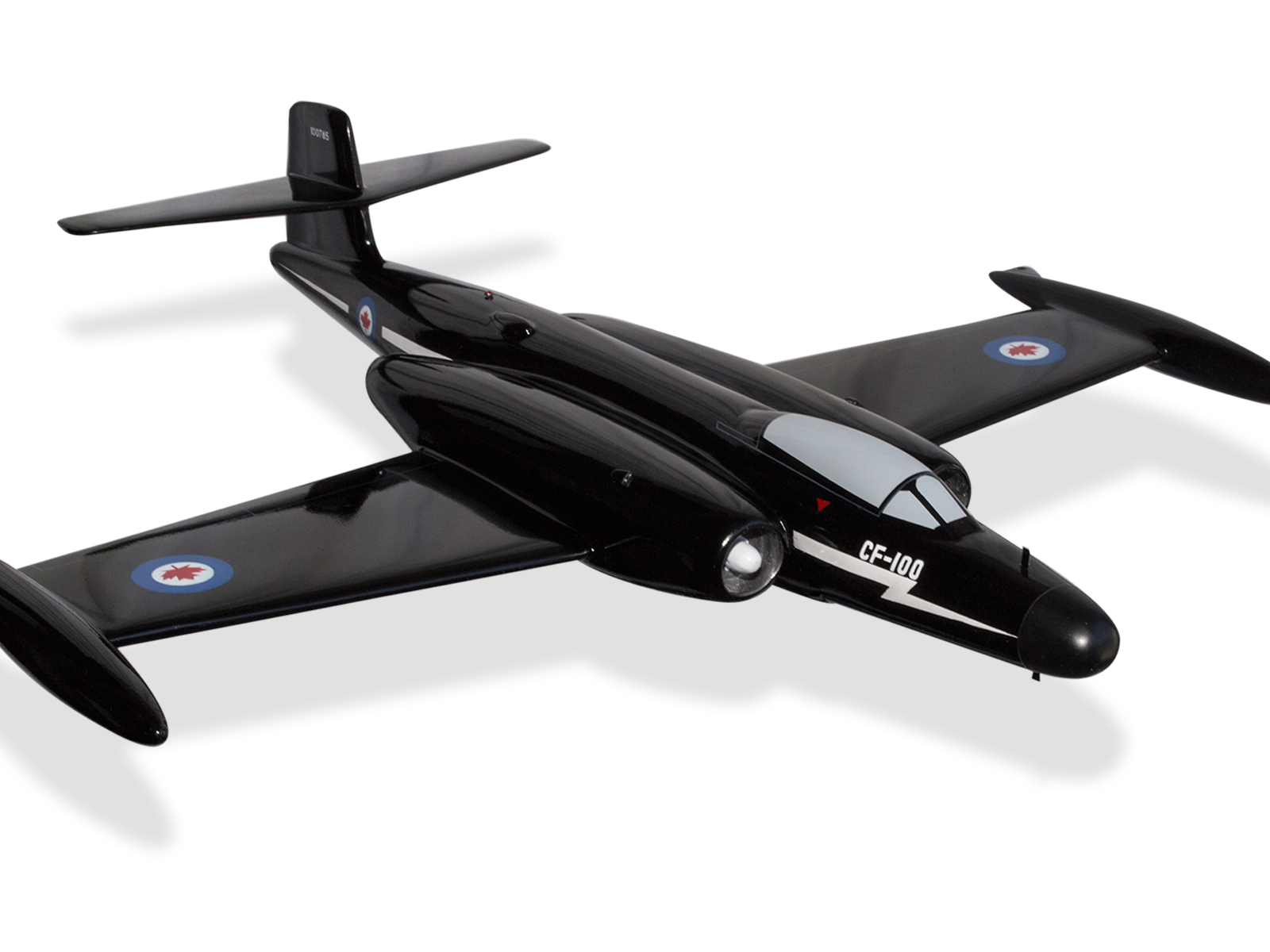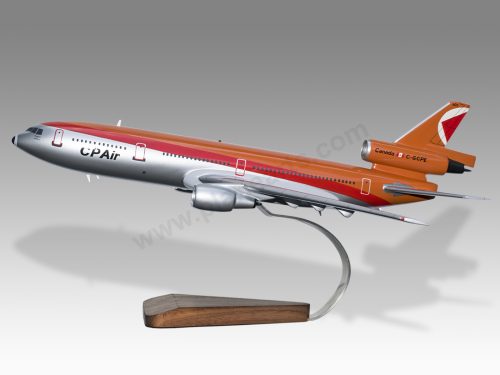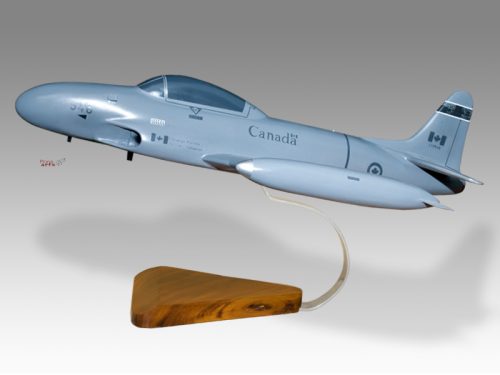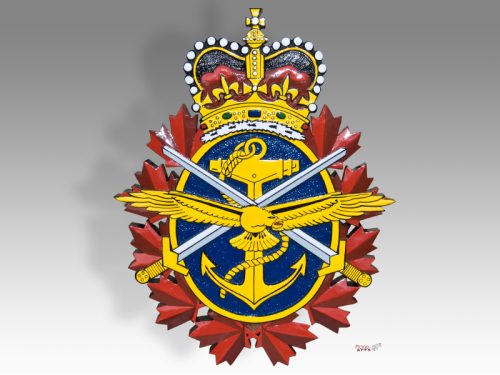Avro Canada CF-100 Canadian Air Force
Production Time 9 to 10 weeks
Shipment is by FedEx, UPS or DHL International Express Courier with a normal door-to-door delivery time worldwide of within 2-3 business days after dispatch. Due to the current volatility of world fuel prices, the amount mentioned here is our best estimate for DHL and UPS and may be subject to change at the time of shipping.

Model Description: Avro Canada CF-100 Canadian Air Force Wood Replica Scale Custom Model Aircraft
Manufacturer: Avro
Wingspan: 17.4 Inches (44.2 Centimeters)
Height: 4.4 Inches (11.2 Centimeters)
Scale: 1:39
$239.50
Production Time 9 to 10 weeks
-
United States dollar ($)
-
Pound sterling (£)
-
Euro (€)
-
Australian dollar ($)
-
Canadian dollar ($)
-
Singapore dollar ($)
-
Swiss franc (CHF)
-
Japanese yen (¥)
-
Danish krone (kr.)
-
Hong Kong dollar ($)
-
Norwegian krone (kr)
-
Swedish krona (kr)
-
United Arab Emirates dirham (د.إ)
General Product Description
Our PlaneArt Avro Canada CF-100 Canadian Air Force model exhibits unique, unrivaled quality and detailed design to come as close as possible to the accuracy of the actual plane. It comes as standard with a robust, durable base or stand which is available in a variety of different finishes designed to match your own personal requirements including solid wood, wood with polished metal supports or adjustable wood wall mount and will be ready within about 9-10 weeks from placement of order.
The Avro Canada CF-100 Canadian Air Force model is made of the finest kiln dried renewable mahogany wood (commonly known as Lauan or Meranti) which has undergone many stages of carving and meticulous and careful sanding giving the beautiful, finished museum quality masterpiece. Many collectors and model connoisseurs demonstrate their preference for genuine handmade and hand painted mahogany wood models rather than plastic or die cast (diecast) alternatives due to the overall look and totally different feel of the item - we trust you will find the same. We can however, if required produce the same model in Solid Cast Resin so just click and contact us for further information. Our craftsmen and gifted artisans ensure that our finely handcrafted model airplanes match the precise blueprint details of the original aircraft. The paint scheme, markings and parts are closely matched, reflecting the original aircraft. This stylish top-quality desktop replica model will surely enthrall anyone who receives this as a gift and for sure one of the most appropriate and desirably collectable gifts for any aviation enthusiast or avid military jet aircraft collector whilst also displaying a perfect resemblance to the actual real life version.
There are many types of military jet aircraft, but the basic types are bombers, fighters, fighter bombers, spotter planes, transporters, patrol aircraft, trainers, and reconnaissance and observation aircraft. All these types of aircraft are used for different types of missions. If you're a fan of historic or present-day military aviation, our model aircraft will bring the excitement and character of these aircraft right into your own home.
If you require, we can also make the Avro Canada CF-100 Canadian Air Force model in any other military, government or even private livery or colour scheme you require and if necessary, in a different size or scale. Just click here to contact us with a description or photographs of what you require, and we will let you have a quotation for the necessary customization by return email. We can also make bespoke scale replicas of any other private / civil commercial airliner or airliners, helicopter, glider, gliders with engines, military propeller, warplane jets, biplane, triplane, tail fin, spacecraft, rocket or NASA model you require in any airline, military or civilian livery or colors. We also produce model airships, blimps, dirigibles, blimps, boats, and ship collectibles. Wall plaque or seal for military, government or private customers. Again, by clicking here to contact us just let us know exactly what you need.
The Avro Canada CF-100: A Legacy of Canadian Air Power
In the annals of aviation history, certain aircraft stand out not only for their technical prowess but also for their cultural significance. Among these is the Avro Canada CF-100, a formidable fighter aircraft that became an iconic symbol of Canadian air power during the mid-20th century. From its inception to its retirement, the CF-100 left an indelible mark on both military and civilian aviation in Canada.
Origins and Development:
The CF-100, designed and manufactured by Avro Canada, emerged during the early Cold War period when Canada sought to bolster its air defenses. The Royal Canadian Air Force (RCAF) required a capable, all-weather interceptor aircraft to protect the vast expanse of Canadian airspace. In response, Avro Canada embarked on the development of what would become the CF-100, with the project officially commencing in 1946.
The design team, led by John Frost, conceived a twin-engine, twin-seat interceptor that prioritized speed, range, and firepower. The CF-100 was revolutionary for its time, featuring a unique straight wing configuration, advanced avionics, and powerful armament. Its distinctive appearance and robust performance earned it the nickname “Canuck” among pilots and aviation enthusiasts.
Technical Specifications:
The CF-100 was a marvel of engineering, boasting impressive specifications that made it a formidable opponent in the skies:
- Crew: Pilot and radar operator
- Length: 16.33 meters (53 feet 7 inches)
- Wingspan: 18.69 meters (61 feet 4 inches)
- Height: 4.59 meters (15 feet 1 inch)
- Empty weight: 12,430 kilograms (27,402 pounds)
- Max takeoff weight: 19,960 kilograms (44,000 pounds)
- Powerplant: 2 × Avro Canada Orenda 11 turbojet engines
- Maximum speed: Mach 0.85 (1,042 km/h or 647 mph)
- Range: 1,528 kilometers (949 miles)
- Service ceiling: 14,630 meters (48,000 feet)
- Armament: Various combinations of cannons, rockets, and missiles
Operational History:
The CF-100 entered service with the RCAF in 1953, marking the beginning of a distinguished career in Canadian military aviation. Initially deployed as an interceptor to counter potential Soviet bomber threats, the CF-100 played a crucial role in Canada’s contribution to NATO’s defense strategy during the Cold War.
One of the CF-100’s most significant achievements was its role as the first aircraft to carry the AIR-2 Genie, a nuclear air-to-air rocket, in Canadian service. This capability underscored Canada’s commitment to NATO’s deterrence policy and showcased the CF-100’s adaptability to evolving defense requirements.
Beyond its military service, the CF-100 found success in various roles, including reconnaissance, electronic warfare, and training. Its versatility and reliability endeared it to pilots and ground crews alike, cementing its status as a Canadian aviation icon.
Legacy and Retirement:
Despite its sterling performance and enduring popularity, the CF-100 eventually succumbed to the march of progress. Advances in aviation technology rendered it obsolete by the late 1950s, prompting the RCAF to gradually phase it out in favor of more modern aircraft.
The last CF-100 squadron was disbanded in 1981, marking the end of an era in Canadian military aviation. However, the legacy of the CF-100 endures to this day, preserved in museums, commemorated in literature, and remembered fondly by those who served with or admired this remarkable aircraft.
Conclusion:
The Avro Canada CF-100 stands as a testament to Canadian ingenuity, innovation, and resilience. From its humble beginnings as a Cold War interceptor to its eventual retirement decades later, the CF-100 left an indelible mark on Canada’s aviation history. Its sleek design, formidable capabilities, and lasting impact ensure that it will forever hold a special place in the hearts and minds of aviation enthusiasts worldwide.
| Weight | 6 kg |
|---|---|
| Dimensions | 16.5 × 17.4 × 4.4 in |
Be the first to review “Avro Canada CF-100 Canadian Air Force” Cancel reply
Similar Models
Military Airplanes - Propeller
Helicopters
Military Airplanes - Jet
Military Airplanes - Jet
Private & Civilian
Military Airplanes - Jet
Military Airplanes - Jet
Military Airplanes - Jet
McDonnell Douglas CF-18 Hornet Canadian Air Force 410 Cougars
Military Airplanes - Jet
Military Airplanes - Jet
Military Airplanes - Jet
Military Airplanes - Jet
Military Airplanes - Propeller
Military Airplanes - Propeller
Military Airplanes - Propeller
Military Airplanes - Propeller
Military Airplanes - Propeller
Military Airplanes - Jet
Private & Civilian
Military Airplanes - Propeller
Tail Shields & Flashes, Plaques & Seals
Military Airplanes - Jet
Military Airplanes - Propeller
Military Airplanes - Propeller
Military Airplanes - Jet
Military Airplanes - Jet
Military Airplanes - Jet
Military Airplanes - Jet
Private & Civilian
Military Airplanes - Jet
Boeing C-17 Globemaster III Canada – Royal Canadian Air Force
Military Airplanes - Jet
Private & Civilian
Private & Civilian
Private & Civilian
Private & Civilian
Private & Civilian
Military Airplanes - Jet
Military Airplanes - Jet
Helicopters
Military Airplanes - Jet
Military Airplanes - Jet





















































Reviews
There are no reviews yet.